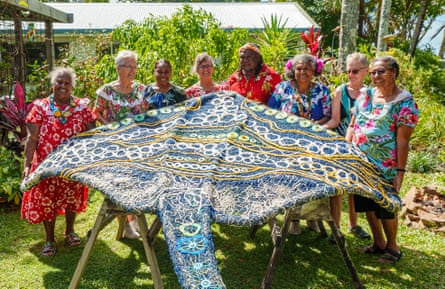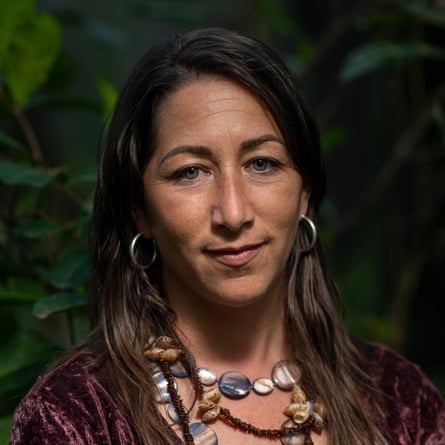Megan Cope calls it the “first mining boom”, one that drove Australia’s oyster reefs to near extinction. First, British colonists raided the enormous piles of shells and animal bones Indigenous people had gathered after feasting and ceremony, mixing these middens with water into a lime slurry for building the new colony.
Then, once these “Aboriginal architectural forms” – sites of carbon-dated evidence of traditional life – were exhausted, the colonisers began demanding live oysters to eat. They sent fishers to deploy harmful extractive processes on the reefs. “Within 15 to 20 years of the British arriving, the landscape changed so incredibly,” says Cope. “Our ancestors were witness to that, but powerless, of course.”
Now the 41-year-old Quandamooka artist is making a monumental sculptural artwork in response. She is overseeing a team of volunteers who are cleaning about 100,000 oyster shells donated from restaurants, which they will tether to 200 poles made of cypress pine. In September, the finished artwork will be placed on the steps of the Sydney Opera House – an area known to the Eora nation as Tubowgule, rich in oysters, mussels, fish, kangaroos and edible plants before the British arrived.

By using volunteers, Cope’s work – already part of a tradition of Indigenous Australian art-making grounded in spiritual and cultural connections to the land – is one of many recent projects that unite Indigenous and non-Indigenous people around a common cause: abuse of the ocean.
A new public artwork, Mermer Waiskeder: Stories of the Moving Tide, consists of 11 colourful eagle rays, measuring three metres long and stretched across aluminium frames, suspended from a ceiling where commuters exit Wynyard station in Sydney. Illuminated at night, the artworks are hand-stitched from “ghost gear” – fishing nets abandoned in the ocean, where they pollute the water and strangle sea turtles, sharks and other animals, including eagle rays, which are found along the Australian coast.

The handcrafted sculptures are the work of the Ghost Net Collective, a collaboration between artists at the Erub Arts centre on Darney Island in the Torres Strait – where the rays are an Indigenous totem – and non-Indigenous artists, formed by Lynnette Griffiths and Marion Gaemers in 2020. “The lights change with the tide,” Griffiths says of the illuminated eagle rays, “going from when the rays would be at the bottom of the ocean, to the rays coming alive, to them swimming and then back down to a breathing, resting pattern.”
The practice of turning nets into art has become part of a wider, global “ghost gear” movement. Across the Pyrmont Bridge, an exhibition at the Australian National Maritime Museum, Au Karem Ira Lamar Lu – Ghost Nets of the Ocean, includes more woven works by Erub Arts, suspended from the foyer ceiling, including a canoe, a large hammerhead shark, turtles, mullet, jellyfish, sardines and squid.

Jimmy Kenny Thaiday, 36, of the Meriam Mir people, led the male artists in weaving the mullets. Known as au wiri, these huge fish are found on a sand quay near Erub, where men traditionally spear them. “We still go out and hunt those mullets and bring them back for families,” he says. He also created the large hammerhead shark, which he named Seim Boy based on a hammerhead he often sees near his village of Seim, where he grew up and today makes digital art – lately about coral bleaching.
The large woven canoe that dominates the space is called the Emeret Nar, he says, meaning “longtime boat”. It is fitted with outriggers and sails bearing the star constellation Tagai, named for a mythic fisherman Torres Strait islander peoples believe created the world. Such canoes, which can carry up to 20 people, have been used for fishing, hunting and trade between Erub and Papua New Guinea.
The ocean “is our livelihood”, says Thaiday. “We are surrounded by it; we draw inspiration from it. It’s our food source.”
Traditional knowledge emphasises sustainability and respect, he says. “When mob go out fishing, you don’t overfish. Even hopping around the islands and picking up fish from the stone fish traps, you only take so much for families, or else you’ll stop the [breeding] cycle.”

The Australian government has contracted Thaiday to make artwork on the impact of human-caused global heating, which particularly affects lower-lying islands in the Torres Strait. “My house is on the beach, and you do see the effects climate change is having,” he says. “I try to do as much as I can to hold all the sand, hold the beach together. The islands are getting washed – spiritual sites, even grave sites. Sea-level rise is right in there.”
His cousin, Jimmy John Thaiday, who was also involved in the artworks, adds that dumped plastic “has been a problem since my grandfathers walked on Earth [and] is now affecting the ocean and wildlife [and] found in sealife gut and also in and around the coral reefs”.

At the Opera House, Cope hopes her work can raise awareness of oyster reef destruction – but also point the way to a more sustainable ocean. When the work is removed from the Opera House, she hopes it will be installed in the water at La Perouse, a peninsula in south-east Sydney. “Oysters fix carbon in their shells,” she says, “and given the amount of water that they clean, if we can set ourselves a goal of restoring 40-50% of oyster reefs – not commercial oyster farms, but oysters that can stay in the water for 50 years without the threat of us taking them – then we might start turning a page, and also address other issues like ocean acidification and the ocean heatwave.”
This theme was behind another of her sculptures last year, called Kinyingarra Guwinyanba (“place of oyster rocks”). Using a small motorboat she planted oyster shells on 40 cypress poles in the waters at Minjerribah (North Stradbroke Island), east of the Queensland capital of Brisbane or Meanjin, where she was born – creating a living oyster reef where the oyster population had been devastated.
Quandamooka, the name of the Aboriginal nation to which Cope belongs and who are the traditional custodians of this area, is also the “mother spirit” of land and water. “She holds all life for us,” says the artist. “She’s the mode of transport, and she’s also the producer of all the food our people have eaten for centuries. Our fundamental job is to look after her.”
